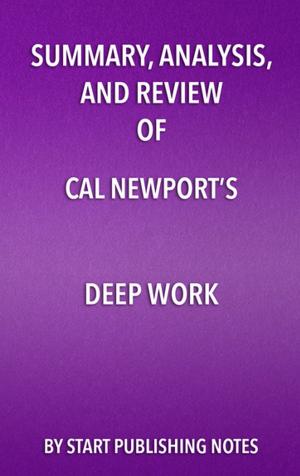Summary, Analysis, and Review of Timothy Ferriss’s The 4-Hour Workweek
Nonfiction, Reference & Language, Study Aids, Book Notes| Author: | Start Publishing Notes | ISBN: | 9781635967258 |
| Publisher: | Start Publishing Notes | Publication: | October 9, 2017 |
| Imprint: | Start Publishing Notes | Language: | English |
| Author: | Start Publishing Notes |
| ISBN: | 9781635967258 |
| Publisher: | Start Publishing Notes |
| Publication: | October 9, 2017 |
| Imprint: | Start Publishing Notes |
| Language: | English |
PLEASE NOTE: This is a key takeaways and analysis of the book and NOT the original book.
Start Publishing Notes’ Summary, Analysis, and Review of Timothy Ferriss’s The 4-Hour Workweek
includes a summary of the book, review, analysis & key takeaways, and detailed “About the Author” section.
PREVIEW: Creativity, Inc.: Overcoming the Unseen Forces that Stand in the Way of True Inspiration by Ed Catmull (with Amy Wallace) takes a close look at the special culture that the author helped establish at Pixar, the computer-generated animation studio that he co-founded. Reflecting on his personal career, his management philosophy, and the highs and lows of Pixar’s history as a company, Catmull discusses strategies for nurturing creativity and diagnoses common problems faced by creative professionals.
In the 1970s, as a graduate student studying computer-generated animation, Catmull was establishing and defining his field even as he studied it. Pursuing computer science had been a second choice, as he felt he lacked the talent to animate by hand. After he received his PhD in 1974, no one wanted to hire him because he was so fixated on the idea of making a computer-generated film—a format that did not then exist.
Start Publishing Notes’ Summary, Analysis, and Review of Timothy Ferriss’s The 4-Hour Workweek
includes a summary of the book, review, analysis & key takeaways, and detailed “About the Author” section.
PREVIEW: Creativity, Inc.: Overcoming the Unseen Forces that Stand in the Way of True Inspiration by Ed Catmull (with Amy Wallace) takes a close look at the special culture that the author helped establish at Pixar, the computer-generated animation studio that he co-founded. Reflecting on his personal career, his management philosophy, and the highs and lows of Pixar’s history as a company, Catmull discusses strategies for nurturing creativity and diagnoses common problems faced by creative professionals.
In the 1970s, as a graduate student studying computer-generated animation, Catmull was establishing and defining his field even as he studied it. Pursuing computer science had been a second choice, as he felt he lacked the talent to animate by hand. After he received his PhD in 1974, no one wanted to hire him because he was so fixated on the idea of making a computer-generated film—a format that did not then exist.
PLEASE NOTE: This is a key takeaways and analysis of the book and NOT the original book.
Start Publishing Notes’ Summary, Analysis, and Review of Timothy Ferriss’s The 4-Hour Workweek
includes a summary of the book, review, analysis & key takeaways, and detailed “About the Author” section.
PREVIEW: Creativity, Inc.: Overcoming the Unseen Forces that Stand in the Way of True Inspiration by Ed Catmull (with Amy Wallace) takes a close look at the special culture that the author helped establish at Pixar, the computer-generated animation studio that he co-founded. Reflecting on his personal career, his management philosophy, and the highs and lows of Pixar’s history as a company, Catmull discusses strategies for nurturing creativity and diagnoses common problems faced by creative professionals.
In the 1970s, as a graduate student studying computer-generated animation, Catmull was establishing and defining his field even as he studied it. Pursuing computer science had been a second choice, as he felt he lacked the talent to animate by hand. After he received his PhD in 1974, no one wanted to hire him because he was so fixated on the idea of making a computer-generated film—a format that did not then exist.
Start Publishing Notes’ Summary, Analysis, and Review of Timothy Ferriss’s The 4-Hour Workweek
includes a summary of the book, review, analysis & key takeaways, and detailed “About the Author” section.
PREVIEW: Creativity, Inc.: Overcoming the Unseen Forces that Stand in the Way of True Inspiration by Ed Catmull (with Amy Wallace) takes a close look at the special culture that the author helped establish at Pixar, the computer-generated animation studio that he co-founded. Reflecting on his personal career, his management philosophy, and the highs and lows of Pixar’s history as a company, Catmull discusses strategies for nurturing creativity and diagnoses common problems faced by creative professionals.
In the 1970s, as a graduate student studying computer-generated animation, Catmull was establishing and defining his field even as he studied it. Pursuing computer science had been a second choice, as he felt he lacked the talent to animate by hand. After he received his PhD in 1974, no one wanted to hire him because he was so fixated on the idea of making a computer-generated film—a format that did not then exist.















